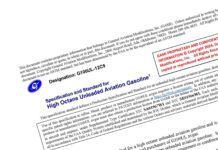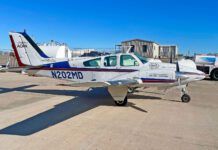Part of every piston-pilots preflight ritual is sumping the fuel tanks to check for water. Given that a modern Cessna has 13 of these fuel drains, wouldnt it be better just to keep the water out?
Thats what Stay-Sealed attempts with a fuel cap to put in place over your existing fuel cap. The company offers covers that fit most single-engine Cessnas and Pipers. The covers arent interchangeable, so order the right type for your airplane.
The cap is applied by pressing down and physically locking over the existing fuel

cap. You need to pull up on the ring at the center to make sure its really in place. It shouldnt pop off. The company claims it will stay on in an 80 mph wind. It comes off with a slight pop when you pull from the corner with no scuffing to the paint.
We tested the Stay-Sealed cover on two high-wing Cessnas by smearing a paste that changes color in the presence of water just inside the filler neck, closing the cap and then drenching the wing until there was standing water. We tried it with an unprotected fuel cap, a canvas aircraft cover and the Stay Sealed cover. (A big thanks to the folks at Cumberland and York Aviation in Biddeford, Maine, for their help with this.)
In each case, we couldnt see obvious water-even with the unprotected cap-but the paste turned from brown to red where water was creeping in. The naked cap fared the worst, as expected. The canvas cover did quite well, but showed a little

water had made it to the fuel cap.
The Stay Sealed cover kept the fuel cap bone dry-once we got it properly installed. Also, it didnt seem to sit equally tight on different airplanes. The company says that if the fuel cap has too much paint on it or the filler neck was bent or improperly repaired, the cover might not fully seat. Stay Sealed offers a refund if youre not happy with the fit on your plane.
Given that the Stay-Sealed caps are $47.75 a piece from the company or Aircraft Spruce, wed lean toward having a cloth cover that protected our windows and extended over the fuel caps, unless water was a serious problem. In that case, these caps might be just the ticket.
Filtering Water Out
Weve used the GATS jars for years to pour contaminated fuel back into our tanks and love the product. The jar has a screen thats too small for water to pass (due to waters surface tension) but lets the fuel through.
The weaknesses of the GATS jar are that the O-ring seal is hard to get back into place if you open the jar to clean it, and that it doesnt fit we’ll in the seat-back pocket. Sportys has a fuel tester cap that uses the same microscreen and fits over the tube many pilots use for fuel testing.
We tried it with the same water-detecting paste and couldnt find any water in the filtered fuel. The filter top is $6.95 if you already have the tube-like fuel tester or $19.95 with the tester. At these gas prices, thats a bargain to keep every ounce of gas you paid for-especially if you have 13 sumps to drain.




